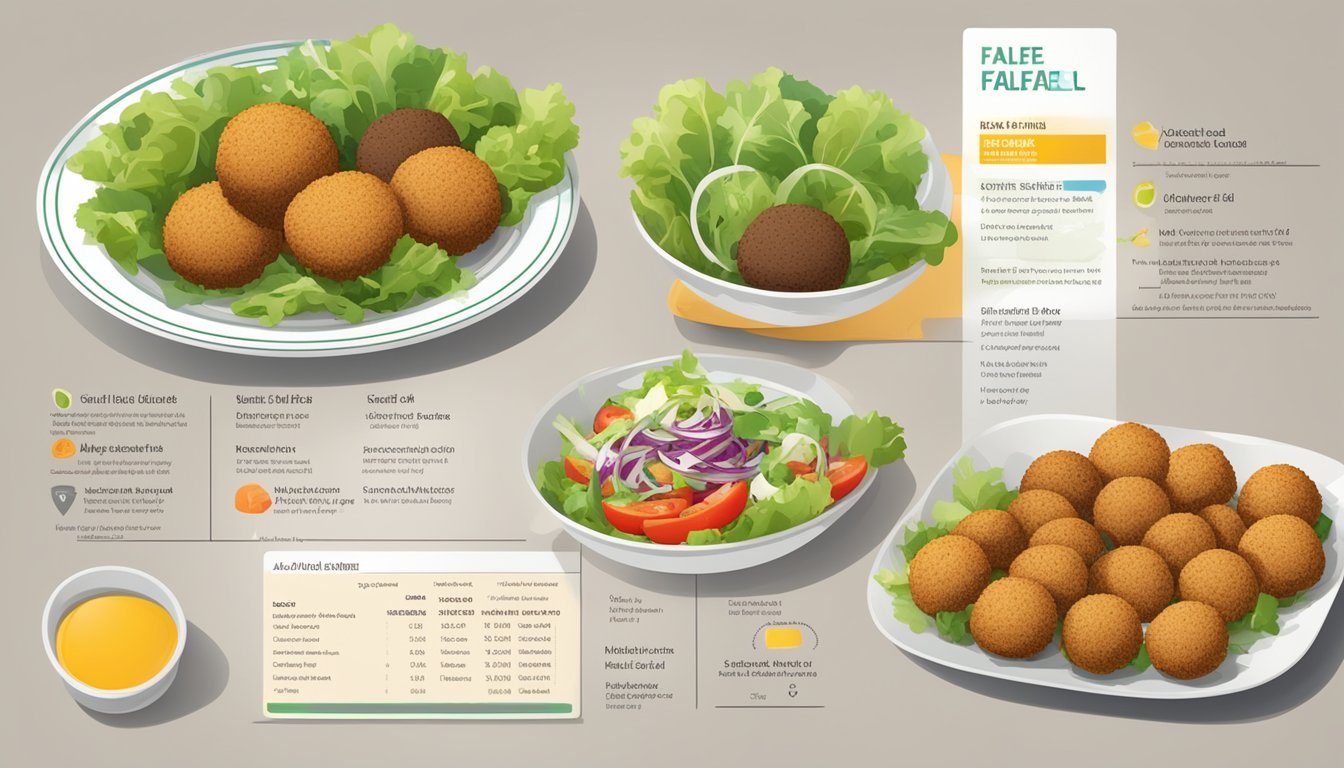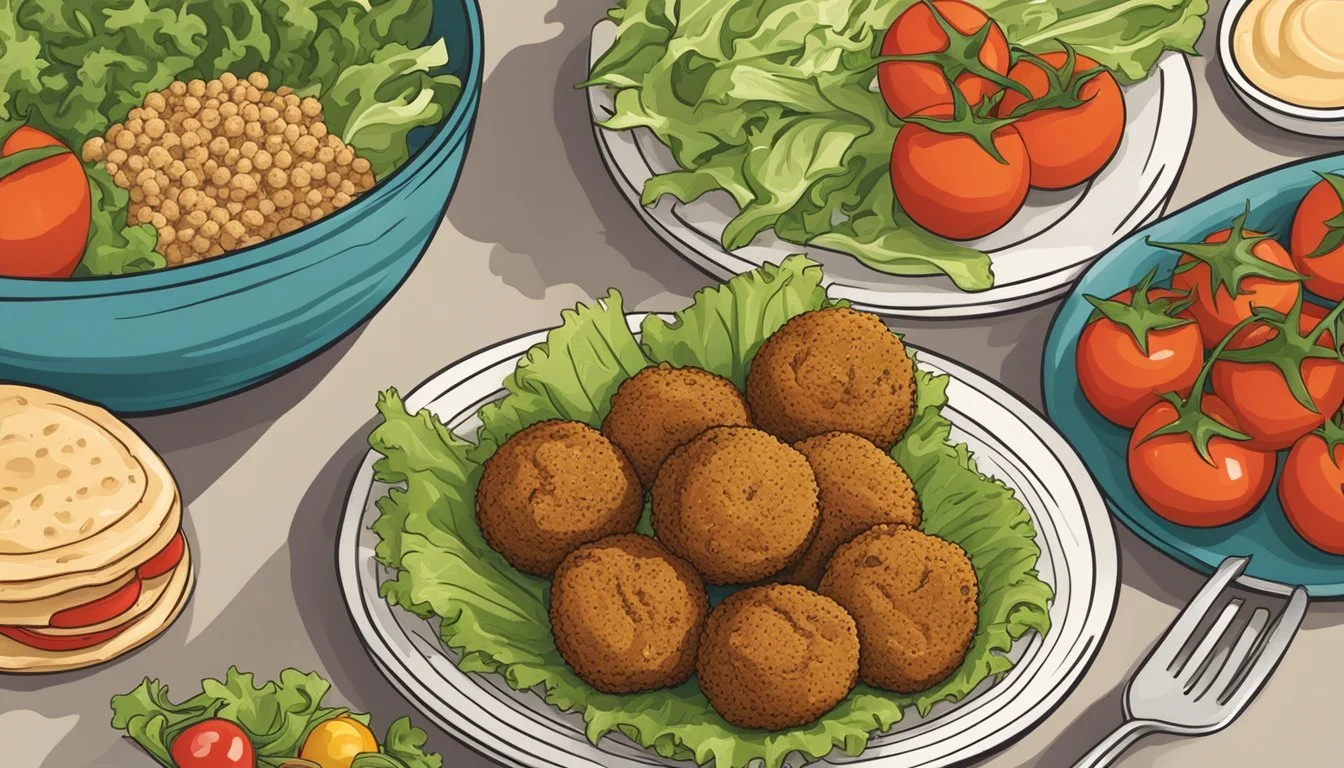How to Reheat Gluten-Free Falafel
Quick & Easy Methods
Reheating gluten-free falafel can be a bit tricky, but with the right method, you can enjoy them as crispy and delicious as when they were freshly made. For the best results, using an air fryer is highly recommended. Preheat the air fryer to around 350°F (180°C), arrange the falafel so they aren’t touching each other, and heat for 2-3 minutes. This method ensures even heating and maintains the crispy texture.
Another excellent way to reheat gluten-free falafel is by using an oven. Preheat your oven to 350°F, wrap the falafel loosely in aluminum foil to prevent drying, and leave them in for about 5-10 minutes. This method is perfect for retaining moisture without compromising on the crispiness.
For a quicker alternative, consider using a skillet. Heat a small amount of oil in a heavy-bottom skillet over medium heat, and place the falafel in the skillet for a few minutes on each side. This method requires close monitoring to avoid burning but will yield delicious results.
The Basics of Gluten-Free Falafel
Gluten-free falafel maintains the traditional taste and texture while excluding gluten-containing ingredients. The preparation focuses on the right combination of chickpeas, flours, and seasonings, along with essential tools to achieve consistency and flavor.
Understanding Gluten-Free Ingredients
Gluten-free falafel primarily relies on chickpeas as its base, providing the authentic taste and texture. Some recipes use canned or soaked dried chickpeas. The right type of flour is crucial; chickpea flour or oat flour is commonly incorporated to bind the mixture without gluten.
Spices such as cumin, coriander, garlic, and cilantro are essential to enhance flavor. Baking powder may be added to the mix for a lighter texture. Ensuring all ingredients are certified gluten-free is key to avoiding cross-contamination.
Essential Tools and Equipment
A food processor is indispensable for achieving the perfect falafel mixture. It combines chickpeas, flours, and spices into a coarse texture. An offset spatula helps in scraping the sides of the processor for even mixing.
For shaping the falafel, hands or an ice cream scoop can be used to form uniform patties or balls. A deep fryer or a heavy-bottomed skillet ensures even cooking. If baking, a baking sheet and parchment paper would be necessary to prevent sticking.
Preparation for Reheating
Proper preparation ensures falafel retains its flavor and texture when reheated. Key steps include storage and prepping falafel prior to reheating.
Best Practices for Storing Falafel
To maintain the quality of falafel, store it correctly right after cooking.
Place the falafel in an airtight container to prevent it from drying out. For short-term storage, refrigerate the falafel, which will keep for up to three days. If you need longer storage, freeze the falafel. Wrap each piece individually in plastic wrap before placing them in a freezer bag. This avoids clumping and facilitates easy reheating.
When freezing, label the container with the prep date to keep track. This helps ensure you use the falafel while it’s still fresh.
Prepping Falafels for Reheating
Before reheating, let refrigerated falafel sit at room temperature for 15-20 minutes. This step reduces the reheating time and ensures even heating.
If the falafel was frozen, it’s best to thaw it in the refrigerator overnight. This slow thawing process preserves texture and flavor.
Pat the falafel dry with a paper towel if it appears too moist. Arrange the falafel pieces so they're not touching each other. This promotes even reheating and prevents sogginess. Use a light spray of oil to help regain a crisp exterior.
Reheating Techniques
When reheating gluten-free falafel, it is essential to retain their crispy exterior and tender interior. Below are three efficient methods to reheat your falafel while preserving its texture and taste.
Oven Reheating Method
To reheat falafel in the oven, start by preheating your oven to 350°F (180°C). Arrange the falafel on a baking sheet, ensuring they are spaced out to promote even heating. Wrapping the falafel loosely in aluminum foil can help prevent them from drying out. Bake for 10 minutes, turning them halfway through the process for consistent crispiness. This method maintains a balance between a crispy exterior and a soft, tender middle.
Steps:
Preheat oven to 350°F (180°C).
Place falafel on a baking sheet.
Optional: Wrap loosely in foil.
Bake for 10 minutes, turn halfway.
Air Fryer Reheating Method
Reheating falafel in an air fryer is quick and efficient. Preheat the air fryer to 350°F (180°C). Place the falafel in the air fryer basket without them touching to ensure crisping on all sides. Heat for 2-3 minutes and check by cutting one open. If it’s not heated through, cook for an additional minute. This method ensures the exterior remains crispy and the inside tender.
Steps:
Preheat air fryer to 350°F (180°C).
Arrange falafel in the basket without touching.
Heat for 2-3 minutes.
Check and heat for an additional minute if necessary.
Pan Frying Reheating Method
Pan frying provides direct heat, which can help in keeping the falafel crispy. Use a non-stick pan or skillet and add a small amount of oil. Heat the pan over medium heat, then place the falafel in the pan. Fry each side for about 2-3 minutes or until heated through, turning occasionally to avoid burning. This method allows for a crispy exterior while keeping the inside moist and tender.
Steps:
Heat a non-stick pan over medium heat.
Add a small amount of oil.
Place falafel in the pan.
Fry each side for 2-3 minutes, turning occasionally.
Each method provides a way to reheat falafel while maintaining its desirable features, ensuring you can enjoy your gluten-free falafel as if they were freshly made.
Serving Suggestions
Reheated gluten-free falafel can be paired with various dips and sides, or integrated creatively into meals. Below are detailed suggestions on how to enhance your falafel experience.
Pairing with Dips and Sides
Falafel pairs wonderfully with dips like hummus and tahini sauce. Hummus brings a creamy texture, while tahini sauce offers a nutty flavor that complements the falafel’s crispiness.
On the side, a fresh salad of mixed greens with lemon juice and olive oil can balance the meal. Add tomato, cucumber, and red onion for added crunch and flavor. A side of pita bread can be used to scoop up the falafel and dips together.
For a heartier meal, consider serving falafel with a side of roasted vegetables or rice pilaf. Adding a sprinkle of cilantro and a squeeze of lemon can elevate the overall taste.
Creative Ways to Serve Reheated Falafel
Reheated falafel can be used innovatively in various dishes. Falafel wraps are popular; simply roll falafels in a pita bread with lettuce, tomato, and a drizzle of tahini sauce.
Another option is to make a falafel salad bowl, where falafel serves as the protein atop a bed of lettuce, spinach, or kale. Add diced cucumber, tomatoes, and a scoop of hummus, and garnish with cilantro and lemon slices.
Falafel can also top a pizza, replacing traditional meat toppings. Use a base of hummus instead of tomato sauce, and add falafel pieces, chopped vegetables, and a sprinkle of tahini for a delicious twist.
Nutritional Information
Understanding the nutritional value of gluten-free falafel helps one appreciate its health benefits and macronutrient profile. This section delves into both aspects in detail.
Health Benefits of Falafel
Gluten-free falafel offers a variety of health benefits, especially for those following vegan or plant-based diets. Chickpeas, the primary ingredient, are rich in protein and fiber. This not only helps with muscle repair and growth but also aids digestion.
The high fiber content supports gut health and can help lower cholesterol levels. Vitamins and minerals, including iron, magnesium, and B vitamins, contribute to overall health. Additionally, since falafel is a plant-based food, it contains zero cholesterol and is typically low in saturated fats, making it heart-healthy.
Caloric and Macronutrient Breakdown
The caloric content of gluten-free falafel can vary based on preparation. On average, one falafel patty (about 50 grams) contains:
Calories: ~80-100
Protein: ~3-4 grams
Fat: ~4-6 grams
Carbohydrates: ~10-12 grams
Fiber: ~2-3 grams
Sodium: ~180-200 mg
Falafel is low in sugar and contains no trans fat. These macronutrients make it a balanced food choice. Note that frying increases the fat content, so opting for baking can reduce calorie and fat intake.
By keeping track of these values, one can better integrate falafel into a balanced diet.
Recipe Variations and Tips
Experimenting with falafel recipes allows for flexibility in dietary preferences while focusing on specific ingredients and techniques to achieve the best reheated falafel.
Modifications for Dietary Restrictions
For those adhering to different dietary guidelines, falafel recipes offer room for substitutions and adjustments. Vegan and gluten-free versions are common. Replace traditional flour with gluten-free flour or chickpea flour, maintaining the binding quality.
For those sensitive to certain herbs or spices, modify the recipe by reducing or replacing cumin and fresh herbs such as parsley. For gluten-free falafel, ensure that all used spices and ingredients, including sea salt and ground coriander, are certified gluten-free to prevent cross-contamination.
Flavor can also be enhanced while keeping the dish compliant by adding ingredients like sesame seeds or combining dried chickpeas with fava beans. These modifications maintain the falafel’s nutritional profile and taste while adapting to dietary needs.
Professional Tips for the Perfectly Reheated Falafel
Reheating falafel while retaining its crispy texture involves several expert techniques. Avoid microwaves, as they can make falafel soggy. Instead, use an oven preheated to 375°F. Place falafel on a baking sheet lined with parchment paper to prevent sticking.
Reheat for 10-15 minutes or until heated through, flipping halfway to ensure an even crisp. A toaster oven can also work for smaller batches, applying the same principles. If using an air fryer, set it to 350°F and reheat for 5-8 minutes.
Maintain falafel’s moisture by lightly brushing or spraying olive oil before reheating. This step helps achieve a golden crust. Storing falafel properly, layered with parchment paper in an airtight container, ensures that it stays fresh and ready for reheating without losing its texture and flavor.
Cultural Significance of Falafel
Falafel, a staple in various cuisines, particularly holds cultural significance in Middle Eastern and Mediterranean diets. Its vegetarian nature also makes it a popular choice in modern global culinary trends.
Falafel in Middle Eastern Cuisine
Falafel is deeply ingrained in Middle Eastern culture, often seen as a symbol of the region’s rich and diverse culinary heritage. Originating from countries like Egypt, Lebanon, and Israel, it is commonly found in local street food markets and traditional meals.
In Middle Eastern cuisine, falafel is frequently served with tahini, hummus, and fresh vegetables in pita bread or wraps. This combination creates a balanced and flavorful meal. Families often prepare it at home using age-old recipes passed down through generations, adding to its cultural significance.
Adaptation in Mediterranean and Global Diets
Beyond the Middle East, falafel has been embraced by Mediterranean cuisine, contributing to dishes such as mezze platters and salads. Its versatility allows it to blend well with other regional flavors, making it a sought-after ingredient.
Globally, falafel has found a place in contemporary diets due to its vegetarian and gluten-free attributes. It has become a common component in modern dishes like buddha bowls and wraps. This adaptation highlights its appeal to various dietary preferences and its integration into mainstream culinary circles.
Social Media and Community
Sharing your gluten-free falafel experiences and engaging with fellow falafel enthusiasts can enhance your culinary journey. Utilizing social media platforms and community forums helps you connect with others, gather feedback, and stay updated with new trends and recipes.
Sharing Your Gluten-Free Falafel Experience
Posting your gluten-free falafel creations on social media platforms like Instagram offers a way to visually document and share your culinary adventures. Capturing high-quality photos of your freshly reheated falafel served with garlic sauce or as an appetizer can attract attention.
Incorporate recipe cards in your posts to provide detailed instructions. This not only helps followers replicate your recipe but also encourages engagement through comments and likes. Followers may share their modifications, leading to insightful exchanges. Ratings and feedback also help you refine your technique.
Engaging with Falafel Enthusiasts
Connect with communities dedicated to gluten-free recipes and falafel-specific discussions. Joining groups on social media or forums allows for sharing tips and learning from others' experiences.
Participate in discussions, answer questions, and post your own queries to deepen your understanding of gluten-free falafel preparation and reheating methods. Sharing your ratings and results from reheating methods can foster constructive dialogue and build a supportive network.
Being an active member of these communities can also introduce you to new recipes and methods, ensuring your gluten-free falafel remains a delicious staple whether served as a snack, appetizer, or part of a fast food meal.








